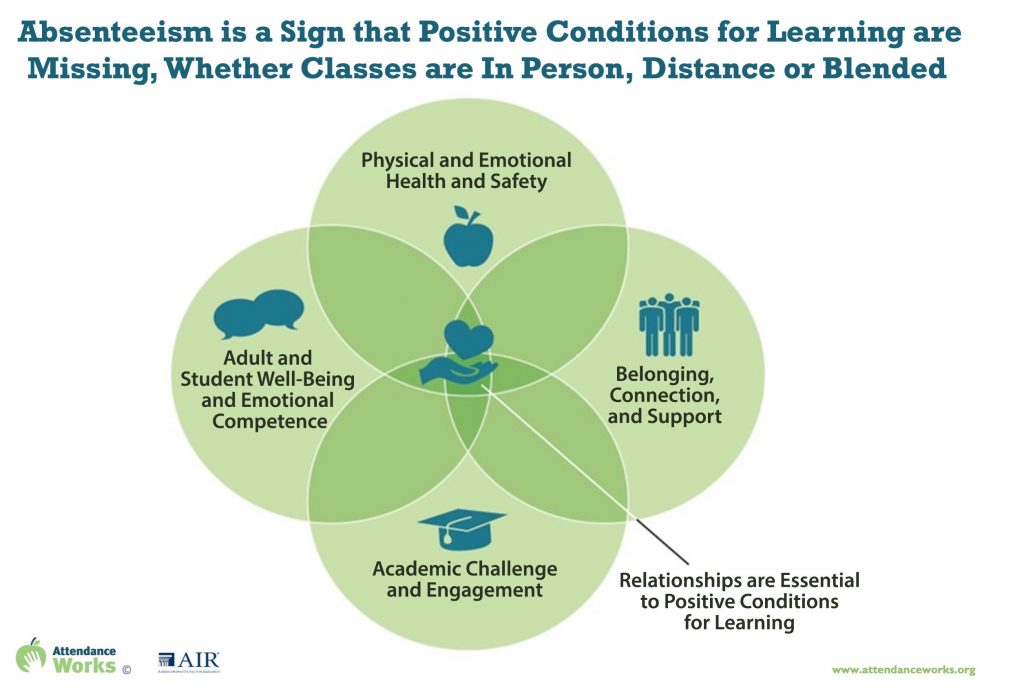We are delighted to publish this guest post by Karen Pittman, who is a partner with KP Catalysts and the creative director Changing the Odds Remix. Karen is also a member of the Attendance Works Advisory Board.
School closings and quarantines will be with us through the rest of the 2021-22 school year, potentially driving absentee rates up even higher than they were at the start of the pandemic. When engaging in discussion, debate or downright standoff over in person or virtual learning, the focus thus far has been on whether students show up. Tamping the impact of future disruptions may require us to think about measuring attendance through an entirely different lens, focusing less on whether they show up and more on how, why, when, where and with whom they connect. To do this, we need to be more explicit about the science behind attending.
School attendance is compulsory in most states until at least age 16. And attendance data is one of the universal indicators used by schools to track both student progress and school success. Attendance is one of the most easily understood and measurable mediators between basic access commitments and achievement goals that schools and communities have. Why do I say attendance is a mediator? Being present is not the same as being engaged. Research shows that chronic absenteeism (missing 10% or more of school for any reason) can translate into students having difficulty learning to read by third grade, achieving in middle school and graduating from high school. This is why Attendance Works has made it a priority to help schools define, collect, and use this data correctly, and, equally important, share it transparently.

The research conducted by Attendance Works and AIR showing the connection between absenteeism and the conditions for learning, however, is also what got me thinking outside of the school walls and the school systems. What happens if we flip the question: If not showing up when it is required is evidence that the conditions for learning are not present, why aren’t we asking students and families to tell us where they are showing up? Aren’t these the places – before and during the pandemic – that somehow managed to help young people feel safe, connected, challenged?
I firmly believe that now is the time to push our conversation on attendance and chronic absenteeism from discussions about showing up to connecting and consider how attendance in settings beyond the classroom might be part of what we formally count and credit.
Collectively, we have the tools and resources to measure and understand the quality of these settings – through the guiding principles for whole child design, the Youth Program Quality Intervention and more. We have research that demonstrates a path from access and engagement to achievement and agency (in both the traditional school setting and community-based youth development settings). But in most communities, we don’t have a specific way to measure and understand what access looks like. Who participates? How often? How do they find the opportunity?
During the pandemic virtual learning was happening in a wide range of physical spaces. This learning has prompted some to create microschools, increased the rate of home schooling, and prompted some youth serving organizations, like the Boys & Girls Clubs in Richmond, Virginia, to become homeschool providers themselves. In each of these examples a system exists that allow for attendance to count. Yet, in most of these cases the burden to access this path falls to parents.
Now is the time to ask and assess:
- Where in the community do young people identify learning opportunities and connections? Where do they feel they are on a path to success?
- How equitable is access to these spaces (and school itself)? Are there specific barriers to overcome?
- How is attendance in these non-mandatory spaces currently measured and how might we place value on that attendance?
- What infrastructure would be needed to support a broader view (and counting) of attendance?
Throughout the next few weeks, the Changing the Odds Remix team will be exploring, and inviting others to explore, what it looks like when we think of chronic absenteeism not just as a problem for schools, but as a community challenge that must be traced back to access issues (i.e., accessibility, basic availability, and social/emotional safety). We welcome your contributions to the topic. Please reach out to talkwithus@kpcatalysts.com if you’d like to join to the discussion.